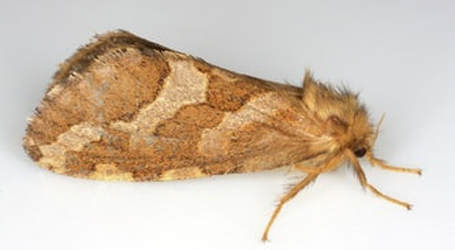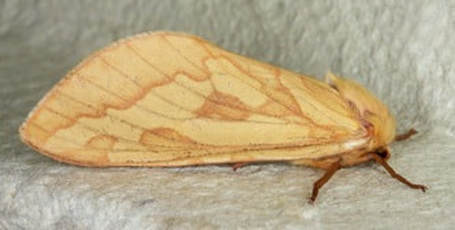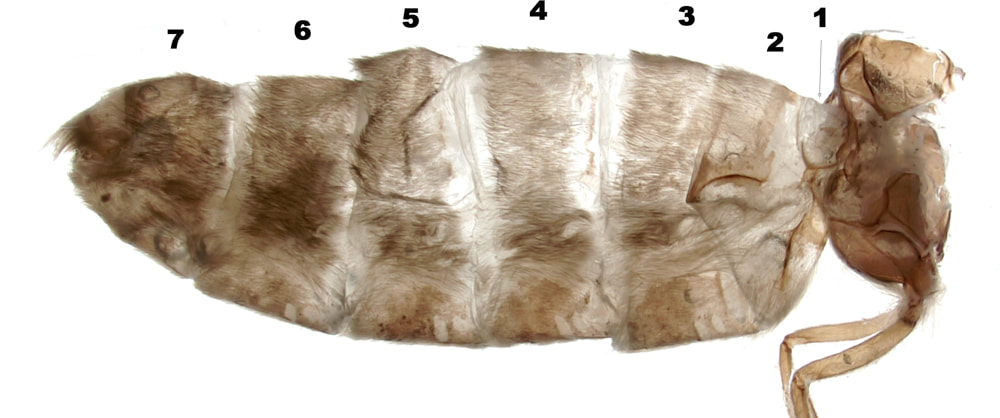The taxonomy of this family has been extensively revised and our 5 British species, formerly all considered within genus Hepialus, have now been placed into 4 separate genera. The rationale for the distinctions between these genera is not clear to me.
Ref: Ghost-moths of the world: a global inventory and bibliography of the Exoporia (Mnesarchaeoidea and Hepialoidea) (Lepidoptera), Journal of Natural History, 2000, 34, 823–878; Nielsen et al.
Medium-sized (ws 25-50mm)
Antennae short - <1/4 length of forewing. Proboscis absent. Labial palps short, drooping and ciliate. Maxillary palps minute or vestigial.
Forewing venation similar to hindwing venation; jugum present; fibula absent; wings held almost vertically at rest.
Females have longer wings with less intense markings than males.
Hindtibiae densely rough-haired. Midtibiae and hindtibiae lack spurs. (Hindtarsi absent in male Phymatopus hecta)
Genitalia very different from all other families. The only family with Exoporian female genitalia - with two genital openings on fused segment 9-10 connected by an external groove. Males have an entirely membranous (unsclerotised) aedeagus.
Four of the five British species are sexually dimorphic - males are shown on the left below.
Ref: Ghost-moths of the world: a global inventory and bibliography of the Exoporia (Mnesarchaeoidea and Hepialoidea) (Lepidoptera), Journal of Natural History, 2000, 34, 823–878; Nielsen et al.
Medium-sized (ws 25-50mm)
Antennae short - <1/4 length of forewing. Proboscis absent. Labial palps short, drooping and ciliate. Maxillary palps minute or vestigial.
Forewing venation similar to hindwing venation; jugum present; fibula absent; wings held almost vertically at rest.
Females have longer wings with less intense markings than males.
Hindtibiae densely rough-haired. Midtibiae and hindtibiae lack spurs. (Hindtarsi absent in male Phymatopus hecta)
Genitalia very different from all other families. The only family with Exoporian female genitalia - with two genital openings on fused segment 9-10 connected by an external groove. Males have an entirely membranous (unsclerotised) aedeagus.
Four of the five British species are sexually dimorphic - males are shown on the left below.
Trioda
001 Trioda sylvina (Orange Swift)
Khorscheltellus (2S)
002 Khorscheltellus lupulina (Common Swift)
003 Khorscheltellus fusconebulosa (Map-winged Swift)
Phymatopus
004 Phymatopus hecta (Gold Swift)
Hepialus
005 Hepialus humuli (Ghost Moth),
Key to species:
|
Forewing with chequered cilia
Forewing unmarked white (cilia buff), 21mm+ Forewing ground colour pale yellowish Forewing with antemedian & postmedian pale fasciae parallel to termen Pale fascial markings form an acute V (point dorsal and open) The rest * |
Korscheltellus fusconebulosa (Map-winged Swift) ♂ and ♀
Hepialus humuli (Ghost Moth) ♂ Hepialus humuli (Ghost Moth) ♀ Phymatopus hecta (Gold Swift) (fasciae white ♂, pale fuscous ♀) Trioda sylvina (Orange Swift) ♂ (antenna lamellate) and ♀ Khorscheltellus lupulina (Common Swift) ♂ and ♀ |
* Common Swift is very variable and may be plain; male fw may be extensively white; where the pale/white markings form a V it is obtuse
|
|
All images © Chris Lewis
Page amended 24/04/2018





















